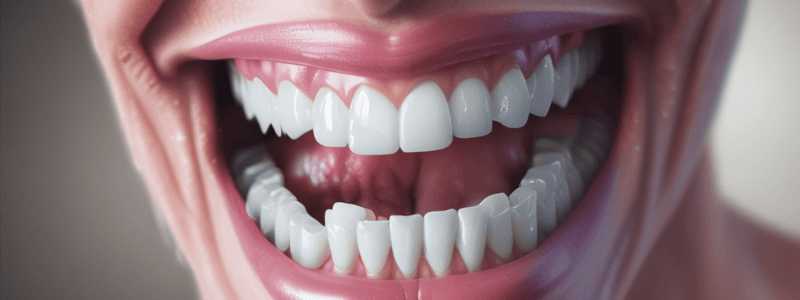Podcast
Questions and Answers
What is the most common type of odontogenic tumor?
What is the most common type of odontogenic tumor?
- Cementoblastoma
- Odontoma (correct)
- Keratocystic Odontogenic Tumor
- Ameloblastoma
What is the typical appearance of an Ameloblastoma on radiographs?
What is the typical appearance of an Ameloblastoma on radiographs?
- Solid, uniform radiodensity
- Radiopaque lesion with a radiolucent center
- Radiolucent lesion with a radiopaque center
- Mixed radiolucent and radiopaque areas (correct)
Which odontogenic tumor is known for its local aggressiveness?
Which odontogenic tumor is known for its local aggressiveness?
- Adenomatoid Odontogenic Tumor
- Cementoblastoma
- Ameloblastoma (correct)
- Odontoma
What is the typical location of a Cementoblastoma?
What is the typical location of a Cementoblastoma?
What is the name of the solution often used in the treatment of Keratocystic Odontogenic Tumor?
What is the name of the solution often used in the treatment of Keratocystic Odontogenic Tumor?
What is the typical location of an Adenomatoid Odontogenic Tumor?
What is the typical location of an Adenomatoid Odontogenic Tumor?
What is the characteristic of an Odontoma on radiographs?
What is the characteristic of an Odontoma on radiographs?
What is the treatment for a Cementoblastoma?
What is the treatment for a Cementoblastoma?
What is the characteristic of a Keratocystic Odontogenic Tumor?
What is the characteristic of a Keratocystic Odontogenic Tumor?
What is the typical symptom of an Ameloblastoma?
What is the typical symptom of an Ameloblastoma?
Flashcards are hidden until you start studying
Study Notes
Odontogenic Tumors
Odontoma
- Most common odontogenic tumor
- Benign, non-aggressive
- Composed of enamel, dentin, cementum, and pulp tissue
- Can be compound (multiple small teeth) or complex (single, irregular mass)
- Typically asymptomatic, discovered on routine radiographs
- Treatment: surgical removal, usually curative
Ameloblastoma
- Second most common odontogenic tumor
- Benign, but locally aggressive
- Arises from ameloblasts (tooth-forming cells)
- Can be solid or cystic, often with a mix of both
- Typically occurs in the mandible, often in the molar-ramus area
- Symptoms: swelling, pain, tooth mobility, and displacement
- Treatment: surgical removal, may require extensive resection
Cementoblastoma
- Rare, benign tumor
- Arises from cementoblasts (cementum-forming cells)
- Typically occurs in the root of a tooth, often in the mandible
- Radiographically, appears as a radiolucent lesion with a radiopaque center
- Symptoms: swelling, pain, tooth mobility, and sensitivity
- Treatment: surgical removal, including the associated tooth
Keratocystic Odontogenic Tumor (KCOT)
- Also known as odontogenic keratocyst
- Benign, but locally aggressive and prone to recurrence
- Arises from the dental lamina or dental follicle
- Can be uni- or multi-locular, often with a cystic appearance
- Typically occurs in the mandible, often in the molar-ramus area
- Symptoms: swelling, pain, tooth mobility, and displacement
- Treatment: surgical removal, often with adjunctive therapies (e.g., Carnoy's solution)
Adenomatoid Odontogenic Tumor (AOT)
- Rare, benign tumor
- Arises from the dental lamina or dental follicle
- Typically occurs in the maxilla, often in the incisor-canine area
- Radiographically, appears as a well-defined radiolucency
- Symptoms: swelling, pain, tooth mobility, and displacement
- Treatment: surgical removal, often with preservation of adjacent teeth
Odontogenic Tumors
Odontoma
- Most common type of odontogenic tumor
- Composed of enamel, dentin, cementum, and pulp tissue
- Can be compound (multiple small teeth) or complex (single, irregular mass)
- Typically asymptomatic, discovered on routine radiographs
- Treatment: surgical removal, usually curative
Ameloblastoma
- Second most common type of odontogenic tumor
- Arises from ameloblasts (tooth-forming cells)
- Can be solid or cystic, often with a mix of both
- Typically occurs in the mandible, often in the molar-ramus area
- Symptoms: swelling, pain, tooth mobility, and displacement
- Treatment: surgical removal, may require extensive resection
Cementoblastoma
- Rare, benign tumor
- Arises from cementoblasts (cementum-forming cells)
- Typically occurs in the root of a tooth, often in the mandible
- Radiographically, appears as a radiolucent lesion with a radiopaque center
- Symptoms: swelling, pain, tooth mobility, and sensitivity
- Treatment: surgical removal, including the associated tooth
Keratocystic Odontogenic Tumor (KCOT)
- Also known as odontogenic keratocyst
- Benign, but locally aggressive and prone to recurrence
- Arises from the dental lamina or dental follicle
- Can be uni- or multi-locular, often with a cystic appearance
- Typically occurs in the mandible, often in the molar-ramus area
- Symptoms: swelling, pain, tooth mobility, and displacement
- Treatment: surgical removal, often with adjunctive therapies
Adenomatoid Odontogenic Tumor (AOT)
- Rare, benign tumor
- Arises from the dental lamina or dental follicle
- Typically occurs in the maxilla, often in the incisor-canine area
- Radiographically, appears as a well-defined radiolucency
- Symptoms: swelling, pain, tooth mobility, and displacement
- Treatment: surgical removal, often with preservation of adjacent teeth
Studying That Suits You
Use AI to generate personalized quizzes and flashcards to suit your learning preferences.




